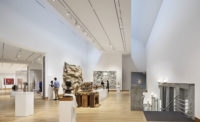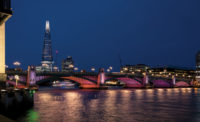Stanton Williams-Designed Art Museum Opens in Nantes, France

Photo © Hufton+Crow

Photo © Hufton+Crow

Photo © Hufton+Crow

Photo © Hufton+Crow

Photo © Hufton+Crow

Photo © Hufton+Crow

Photo © Hufton+Crow

Photo © Hufton+Crow

Photo © Hufton+Crow

Photo © Hufton+Crow

Photo © Hufton+Crow

Photo © Hufton+Crow

Photo © Hufton+Crow

Photo © Hufton+Crow














Architects & Firms
Stanton Williams’ $55-million renovation of the Musée d’arts de Nantes, in western France, which opened to the public on June 23rd, has reordered the museum’s home in a 19th-century Beaux Arts palace, and linked it to three other new and existing buildings dispersed within an adjacent urban block. The resulting ensemble forms an “architectural promenade” through a new “museum quarter,” says Patrick Richard, project director at the London-based firm.
Encouraging new visitors was a central ambition of the project, and stripping away iron gates and widening the entrance stairs have given the imposing, largely windowless palace a more open aspect. In the vaulted stone entrance hall, three arched portals offer a choice of routes through the building, whose galleries are arranged enfilade on two levels around a glass-roofed central ‘patio.’
A chronological progression through the extensive collection of artworks dating from the 13th Century to the present begins by looping counter-clockwise around the ground floor, but shortcuts lead to later works in the top-lit, 27-foot-high galleries on the upper level, and to contemporary art in a new detached extension, known as the ‘Cube.’
Linked to the palace on the second floor by a bridge over a public route, the 21,500-square-foot Cube provides four floors of galleries. It adjoins an outdoor sculpture court which also connects to the remaining pieces of the ensemble: a 17th-century chapel that houses a video work by Bill Viola, and a new center for graphic arts inserted between residential buildings.
The two new buildings act as contextual hyphens, whose sober fabric and forms mediate between existing neighbors. Both are principally clad in pale stone, with flush, minimally-detailed facades. A screen enclosing a stair on the Cube’s south side makes a subtle allusion to the richly ornamented palace, however. Comprising thin sheets of veined marble laminated between panes of glass, it is suspended from the roof by thick steel cables. By day, the translucent stone casts shadows on the glass walkways behind: at night, the building glows from within.
“Light is the major theme,” says Richard. It is drawn deep into the buildings through cuts in the section and carefully positioned windows, and used to create a rich play of reflection, shadow, and contrast. Daylight drops down elevator shafts, backlighting opaque glass enclosures. In the de Chirico-esque patio, whose sheer white walls are punctured by arched openings, delicate shadows are cast on a stretched fabric ceiling by the pyramidal glazed roof.
Pitched skylights over the upper-floor galleries were also discretely modified. New clear glass fitted into existing steel frames preserves the building’s outward appearance, while additional layers of glazing and solar shading are screened from internal view by diaphanous stretched fabric. Though the skylights could illuminate the galleries brightly at all times, says Richard, “we set it up to create shadows, to let people know that they are under the sky. Passing clouds create poetic moments.”
Electric light is also used to atmospheric effect. In the newly excavated basement, it seeps through metal mesh ceilings to produce strong shadows in a basket-weave pattern.
Here, original brick and stone foundations are exposed, along with a new concrete structure, but these are counterpointed by warm oak and patinated bronze. A wood-lined auditorium with an undulating ceiling resembles a musical instrument. In the white-walled galleries, too, Stanton Williams has added color and texture. Deep-hued accents are made by the painted faces of insulating panels that partially line external walls, and large freestanding structures with chamfered corners provide additional display space for paintings and sculpture. Their angular forms break down the scale of larger galleries and “introduce another dynamic of space—something we’ve been experimenting with for 30 years,” says Richard.
Though the architects have pursued an “art first” approach, and were careful that architectural features not distract from the artworks, their renovation has done much more than make a container for a collection. Nantes’ art museum is now a place where visitors feel welcome, engaged, and elevated by their environment.



















